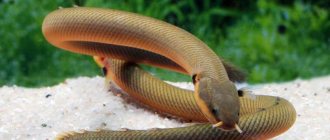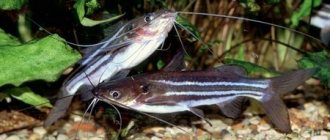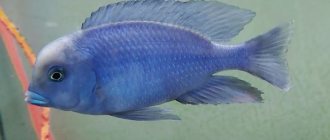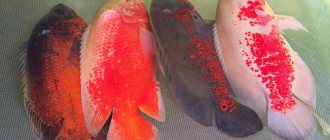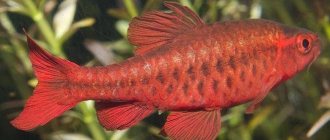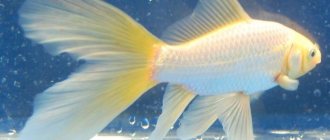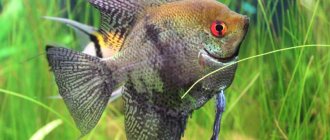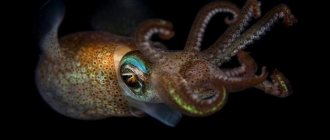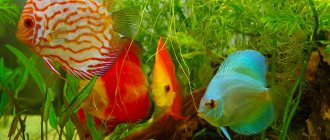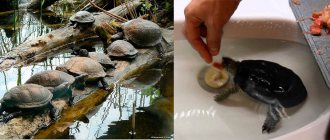Polypterus. Thank you for being alive!
Polypterus have lived on our planet for a very long time. It is assumed that the first representatives of the species appeared in the last period of the Mesozoic era - the Cretaceous, no joke, the species existed for about 60 million years! As befits an ancient fish, the structure of its body is very archaic. The skeleton of the fish resembles a shark and is not bones, but cartilage.
Like fossil fish species, polypterus are capable of breathing atmospheric air. The swim bladder of the fish is divided into two compartments and is similar in structure to the lungs of mammals.
Modern polypterus are common in fresh water bodies of Africa and India. Polypterus prefers muddy water and heavily silted bottom. Can live in swamps. Polypterus navigates in muddy, opaque water thanks to its keen sense of smell. On the contrary, the fish's vision is rather weak.
Polypterus congolese or ornatipinis ((Polypterus Ornatipinnis)
It also has the unofficial name “Marble Dragon”. Can reach a length of 40 centimeters. Very aggressive. It leads a hidden lifestyle, so you can only see it while eating.
The color is gray-brown with a mottled white pattern, the belly of the fish is lighter yellowish, the head is covered with a mesh pattern.
The minimum volume of the aquarium is 400 liters. Water parameters: temperature 24-27 ºC, pH 6.0-8.0, dGH 5-25°.
Feeding
The multi-feathered Senegalese is unpretentious in feeding and will eat almost anything as long as it is alive. If the fish is too big to swallow, he will try anyway.
That is why the neighbors in the aquarium should be at least half the length of the polypterus. Adults can be fed once or twice a week.
Fortunately, you can feed him other foods as well. Granules or tablets that fall to the bottom, live, frozen, sometimes even flakes, he is not capricious.
If you feed it with artificial food, the predatory instinct is reduced, allowing you to keep it with smaller fish.
Endlicher's Polypterus or Tiger (Polypterus Endlicheri Bichir)
Polypterus Endlicher
Polypterus Endlicher
Quite a large representative of the species. Distributed from tropical zones of Africa to the Red Sea. It can reach seventy-five centimeters in length. Discreetly painted. Gray-blue body with pronounced stripes. Very strong, but slow. In nature it is most active at night, but in a home aquarium it will always be active. It is possible to keep it in a home aquarium, but only separately in a volume of at least a thousand liters. Feeding is possible only with live food.
The most comfortable water parameters for keeping: temperature 22-27°C, pH: 6.0-8.0, 5-25°H.
Main characteristics
The unusual fish Polypterus is not at all a friendly creature, but a real predator. They prefer to hunt wisely, waiting for their prey. These creatures see poorly, so they navigate in space by smell.
They are often confused with eels, but they are a completely different species. The Senegalese fish has strong scales that look like armor. Eels have no such protection. Wild individuals of Polypterus can grow up to 50 cm in length. These are long-lived fish, they can live up to 30 years.
Another feature of multi-feathers is the absence of a swim bladder. Fish have a lung, thanks to which they are able to breathe air from the surface. That is why individuals can go without water for a long time, provided that the body is wet. The most common color is blue-gray. The body of the fish has an elongated, serpentine shape.
Polypterus delhezi
Perhaps the brightest of the polypteruses. The body is gray-olive with dark stripes and black dots. The sizes are not large. The body length will not exceed thirty-five centimeters. Suitable for keeping in a fairly modest sized aquarium. Active at night. Spends the whole day in hiding.
Water parameters: temperature – 24–28 °C, hardness – 5–8 °, pH – 6.0–8.0.
Kalamoicht calabarensis
Kalamoicht
It feeds on fry and small fish. Due to the structure of the body, it is able to penetrate into relatively small cracks and depressions. Read more about kalamoichta here .
Interesting Facts
The African polyfin is a frequent inhabitant of demonstration aquariums. Its relic appearance makes it very attractive and mysterious. Where Polypterus senegalese lives, video is often filmed. After all, the active and businesslike behavior of the dragon fish is a very entertaining sight. The predator quickly becomes attached to its owner and swims out of its hiding place to meet him. If the integument of the body is kept moist, the dragon can live without water for a very long time. At the beginning of the 20th century, photos of Senegalese polypterus were sold for a lot of money.
Polypterus senegalus
polypterus senegalese
polypterus senegalese
This species is rightfully considered the most popular among aquarists. This is the type that will be discussed in this article. Senegalese polypterus is very active and quite friendly to fish of its own species and large fish of other species. Due to its external resemblance, it is sometimes confused with an eel, but, naturally, it has nothing to do with eels. The body length when kept in an aquarium does not exceed forty centimeters; in natural conditions it can exceed seventy centimeters. Senegalese polypterus is painted silver with a hint of blue. There are albinos. The scales are small, diamond-shaped.
This type of polypterus is double-breathing. Thanks to this feature, it is able to do without water for some time and even move on land, but not as deftly as Clarius, for example.
Keeping Polypterus in an aquarium
polypterus
Polypterus is a very strong fish with very good health. A real fighter. To keep one Senegalese polypterus you will need an aquarium of at least two hundred liters, preferably more. A lid is required! Polypterus can not only jump, but also crawl out of the aquarium. It is necessary to leave a layer of air between the lid and the surface of the water, otherwise the fish will have nothing to breathe.
Water parameters for keeping polypterus: acidity pH level of seven units, the fish is undemanding about water hardness, will feel equally good in soft and hard water, however, it is better not to experiment with extremely hard water (more than twenty units). Filtration is required. Despite the fact that Polypterus itself does not need aeration, it will not be superfluous for the aquarium ecosystem.
polypterus photo
The most important thing is that there are no excessive concentrations of nitrogen compounds and phosphates . This is the main problem for fish that beginners make. Ammonia, nitrite, nitrate, phosphates are the root cause of illness and death in pets. Every conscientious aquarist should always have a set of drop tests on hand, at least for nitrate and phosphate. Fortunately, they have now become inexpensive, there are no problems with their assortment and acquisition. For example, we can with a clear conscience recommend you the cool UHE drop tests, , but they are sold only online. In stores in your city - offline, you can find inexpensive Vladox tests .
It would be useful to use Tetra EasyBalance , fish produce large amounts of phosphates and nitrogen to be healthy. High-quality water, preparations that remove excess nitrogen and phosphorus are our everything.
The decor of the aquarium can be anything you want. Stones, grottoes, and castles will do...Live plants are desirable, but not required. If all maintenance conditions are met, your ancient pet will live for about ten years.
polypterus
Compatibility of Polypterus with other fish. Fish of comparable size to it are suitable as neighbors for an adult Senegalese polypterus. Indian knives, astronotuses, large cichlids, and African acaras can easily get along with it. Young polypterus can be kept in a small flock, but for adults such keeping is categorically unacceptable.
In rare cases, an adult polypterus can attack fish even larger than itself, but it does this not out of malice or because of the instincts of a hunter, but because of its weak eyesight.
polypterus photo
Feeding Polypterus. Polypterus is a typical predator. Prehistoric death machine. For a comfortable life, he needs to hunt. Ideally, it should be fed with live fish. In addition to this, the dinosaur can be fed with bloodworms and worms, and sometimes a zoobus is used.
Polypterus is a predator, but a leisurely predator. He will not grab the food right away, as if tracking down prey. It also eats leisurely, unlike the same ones: eel and clarius . Among the branded dishes, we recommend feeding your fish with proven, high-quality Tetra food.
It should be noted that when purchasing any dry food, you should pay attention to the date of its manufacture and shelf life, try not to buy food in bulk, and also store the food in a closed state - this will help to avoid the development of pathogenic flora in it.
Diseases and treatments
The Senegalese predator has strong health and rarely gets sick. His immunity can weaken only due to violation of the conditions of detention. For example, polypterus can get sick due to poor nutrition. Since he eats protein foods, he cannot be overfed (the fish can become obese). Symptoms of this disease are apathy and lethargy. The dragon may simply lie there and not react to what is happening around it. The abdomen of an obese polyfin is rounded. Due to obesity, metabolism is disrupted, and some internal organs (for example, kidneys) may fail. If the fish is left untreated, it may die. A sick polypterus needs to be put on a diet - fed once every 3-4 days. Low-fat bloodworms are suitable as food.
If a multi-feather breathes heavily and often rises for air, it means that it has parasites. These are monogenean fluke parasites. A weakened fish may refuse to eat, become “lazy” and move little. You need to take a closer look at the dragon's head (worms may be visible). A number of means can be used to remove parasites:
- malachite green;
- formalin;
- chlorophos;
- methylene blue;
- azipyrine.
You don’t have to remove the fish, but instead put the medicine in the usual water. If you slightly increase the water temperature (by 1–2 °C), the worm will leave the dragon’s body and enter the water that has already been treated with the medicine.
If Polypterus has darkened gills, it may have been poisoned. This often happens due to the filter not working correctly or being dirty. The dragon, poisoned by ammonia, tries to get out of the water and does not eat well. His fins may turn red. A secondary symptom is ruffled scales. First you need to make sure that it is poisoning. A test for high ammonia levels can be purchased at any pet pharmacy. A contaminated aquarium must be thoroughly cleaned, all dirt must be removed from the bottom, the filter must be removed and the sponge rinsed with running water. In addition, you need to replace part of the water (at least a third of the total volume).
During general cleaning, it is better to transplant the fish into a separate tank with pre-prepared water. Some aquarists also include vitamins in the treatment process.
Change the water of day 4 every day by 20 percent - this will remove ammonia and the medicine. When the redness disappears, we will solve the second problem, we need to boost his immunity: you can drip fishtamin (these are vitamins), the scales may go down on their own, but they may not.
Breeding polypterus at home
polypterus photo
In fact, most of the polypterus found in markets are wild caught. Breeding polypterus in a home aquarium is difficult, but possible. Spawning can be stimulated by lowering the water temperature.
The mating season of these fish begins in mid-summer and lasts about three months. During courtship, a pair of polypterus spins in a mating dance, touching their bodies, sometimes biting each other. The eggs of this fish are very small, so it is best to add mosses to the aquarium. The smallest eggs will settle on them. Javanese, string or chrismas will do.
As soon as the fish spawn, the moss along with the eggs that have settled on it must be removed so that the parents do not dine on the offspring. The larvae hatch from the eggs on the fourth day after spawning. Newborn polypteruses are fed Artemia nauplii. Juveniles will have visible external gills, which will disappear as they mature. The fry will begin to hunt very early, including weaker fry. To save most of the offspring, it is necessary to sort the fry by size and house them separately.
polypterus photo
Without a doubt, Polypterus is an amazing fish. Living proof of Darwin's theory of evolution! If you decide to keep it at home, your aquarium will turn into a piece of a completely different, long-lost world, where strength, endurance and the ability to adapt rule!
Compatibility with other fish
In terms of compatibility, the most important parameter is the size of neighboring individuals. The fish should be the same size. The following species will be good friends for polypterius:
- apteronothus;
- shark barbs;
- butterfly fish;
- giant gourami;
- astronotuses;
- cyclides are large;
- Indian knives;
- African cancers.
Young polyfins can be kept in a small school, but for adult fish such keeping is unacceptable. Sometimes adults can attack waterfowl that are larger than them, but such situations do not happen out of malice, but due to poor eyesight.
In terms of compatibility, the most important parameter is the size of neighboring individuals.
A little history
It is generally accepted that these creatures appeared in ancient Africa during the Cretaceous period, which is more than 60 million years ago. As evidence of such a distant origin, the primitive anatomy of polypterus is given: a cartilaginous skeleton, which is similar in design to a shark or stingray, the location of the cranial plates and some others.
The genus has two subspecies:
- Erpetoichthys with the only representative Kalamoichthys calabar (snake fish),
- Polypterus with numerous species and subspecies.
How to choose?
Healthy polypterus have the following characteristics:
- calm, smooth movements;
- absence of growths on the fins;
- uniform color;
- no damage to the scales;
- integrity of the tail and fins.
When deciding to buy a polypterus, you need to remember that such a pet lives for at least 10 years. And if there are doubts that caring for him throughout this period will not be a burden, it is better to think about purchasing other fish.
Reviews
Senegalese polypterus is a unique aquarium animal, more suitable for experienced aquarists or scientific observations. For beginners, keeping such a pet will be a troublesome task: caring for a large aquarium is labor-intensive, the choice of neighbors in the aquarium community is limited, the predator hides in shelters almost all the time and it is not interesting to observe it at home. But if this animal does settle in the aquarium, its owner can be considered the happy owner of a real relic value.
Would you like to have a polypterus? Or maybe among our readers there are happy owners of such a fish? Share your experiences and thoughts in the comments.
Various uses of the plant
Photo: Beautiful Turcha marsh
- The species is used in folk medicine to treat diseases, including heart problems.
- The seeds are characterized by a lack of innate dormancy, the ability to remain viable after drying, and the ability to germinate in a relatively wide range of temperatures in light and an aerobic environment, making the feather an easy species to propagate.
- Oxygenating plants are a good solution for keeping your pond water clean and healthy. They produce and restore oxygen necessary for the life of fish and the breakdown of organic substances by bacteria. These include hotonia. Its leaves are not only oxygenators, but also a refuge for fish and various small aquatic organisms.
- The flower extract of the plant is included in homeopathic medicines. For example, “Water is purple.” This is a flower essence for people who tend to be aloof and closed off, appear cold and keep their problems to themselves. Prescribe 10 drops orally 3 times a day. Directions for use: Take 2 drops in a small glass of water and swallow at regular intervals or place directly on tongue.
Turcha is an excellent choice for your home aquarium. The wide growth habit makes the species suitable for planting between very short and tall plants. Chotonia can be pruned to create a distinctive median shrub in an aquascape, where its feathery, snowflake-like bright green foliage provides an unusual contrast to other species. This is often used in Dutch style layouts. As you can see in the photo, the Turcha plant decorates the aquarium with its bright appearance.
Habitat
In its natural environment, Polypterus lives mainly in the Congo River. In addition, representatives of this species were found in all kinds of silted waters of lakes and rivers of the Republic of Congo and the State of Congo. At the beginning of the 2000s, the species was first brought to the USA, where now aquarium lovers can easily buy it at any pet store. It is noteworthy that both fish grown in artificially created reservoirs and those raised in the natural environment can be sold. Based on numerous comparisons and descriptions of Polypterus delgesi, we can say with certainty that individuals caught in nature differ from those bred artificially. Representatives of this species, born in aquariums, have a duller color than their wild counterparts.
